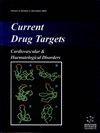Chitosan-Based Nanocarriers for Pulmonary and Intranasal Drug Delivery Systems: A Comprehensive Overview of their Applications
IF 2.5
4区 医学
Q2 PHARMACOLOGY & PHARMACY
引用次数: 0
Abstract
: The optimization of respiratory health is important, and one avenue for achieving this is through the application of both Pulmonary Drug Delivery System (PDDS) and Intranasal Delivery (IND). PDDS offers immediate delivery of medication to the respiratory system, providing advantages, such as sustained regional drug concentration, tunable drug release, extended duration of action, and enhanced patient compliance. IND, renowned for its non-invasive nature and swift onset of action, presents a promising path for advancement. Modern PDDS and IND utilize various polymers, among which Chitosan (CS) stands out. CS is a biocompatible and biodegradable polysaccharide with unique physicochemical properties, making it well-suited for medical and pharmaceutical applications. The multiple positively charged amino groups present in CS facilitate its interaction with negatively charged mucous membranes, allowing CS to adsorb easily onto the mucosal surface. In addition, CS-based nanocarriers have been an important topic of research. Polymeric Nanoparticles (NPs), liposomes, dendrimers, microspheres, nanoemulsions, Solid Lipid Nanoparticles (SLNs), carbon nanotubes, and modified effective targeting systems compete as important ways of increasing pulmonary drug delivery with chitosan. This review covers the latest findings on CS-based nanocarriers and their applications.用于肺部和鼻内给药系统的壳聚糖基纳米载体:应用综述
:优化呼吸系统健康非常重要,而实现这一目标的途径之一是应用肺部给药系统 (PDDS) 和鼻内给药 (IND)。肺部给药系统可将药物直接输送到呼吸系统,具有持续的区域药物浓度、可调药物释放、延长作用时间和提高患者依从性等优势。IND 以其非侵入性和起效迅速而著称,是一条前景广阔的发展道路。现代 PDDS 和 IND 采用了各种聚合物,其中壳聚糖(CS)最为突出。壳聚糖是一种生物相容性和可生物降解的多糖,具有独特的物理化学特性,非常适合医疗和制药应用。CS 中含有多个带正电荷的氨基,可促进其与带负电荷的粘膜相互作用,使 CS 易于吸附在粘膜表面。此外,基于 CS 的纳米载体也是一个重要的研究课题。聚合纳米颗粒(NPs)、脂质体、树枝状分子、微球、纳米乳液、固体脂质纳米颗粒(SLNs)、碳纳米管和改性有效靶向系统都是壳聚糖增加肺部给药的重要途径。本综述涵盖了基于壳聚糖的纳米载体及其应用的最新研究成果。
本文章由计算机程序翻译,如有差异,请以英文原文为准。
求助全文
约1分钟内获得全文
求助全文
来源期刊

Current drug targets
医学-药学
CiteScore
6.20
自引率
0.00%
发文量
127
审稿时长
3-8 weeks
期刊介绍:
Current Drug Targets aims to cover the latest and most outstanding developments on the medicinal chemistry and pharmacology of molecular drug targets e.g. disease specific proteins, receptors, enzymes, genes.
Current Drug Targets publishes guest edited thematic issues written by leaders in the field covering a range of current topics of drug targets. The journal also accepts for publication mini- & full-length review articles and drug clinical trial studies.
As the discovery, identification, characterization and validation of novel human drug targets for drug discovery continues to grow; this journal is essential reading for all pharmaceutical scientists involved in drug discovery and development.
 求助内容:
求助内容: 应助结果提醒方式:
应助结果提醒方式:


